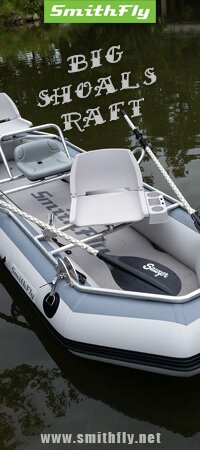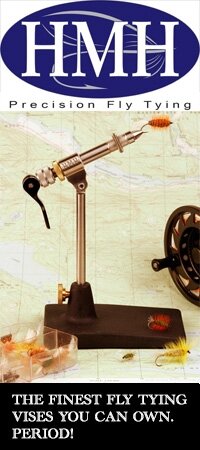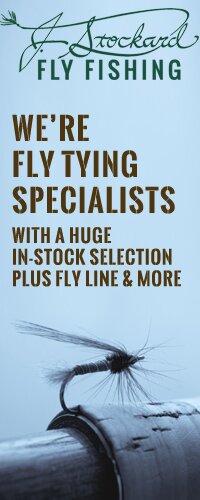 Two weeks ago I posted about the classic Michigan dry fly, Roberts’ Yellow Drake. I planned on digging for more information about Clarence Roberts, but the digging has already been completed. Tom Deschaine has spoke with Clarence’s living relatives and wrote this nice article about the fly tyer, Clarence Roberts.
Two weeks ago I posted about the classic Michigan dry fly, Roberts’ Yellow Drake. I planned on digging for more information about Clarence Roberts, but the digging has already been completed. Tom Deschaine has spoke with Clarence’s living relatives and wrote this nice article about the fly tyer, Clarence Roberts.
The one thing that comes to mind when you think of Michigan and fly fishing is the ‘Roberts Yellow Drake’ and Clarence Roberts. His fly was and is one of the most popular flies of Michigan lore.
It all started back in the late 1930s, when Clarence’s brother Cliff bought “the whole nine yards” of fly tying equipment from a Herters Catalog. When Cliff joined the Army Air Corp in 1942 he passed on all of his tying equipment to Clarence. Fly tying rapidly became not only a hobby but a passion with Clarence. He was good at it, and he loved it.
In 1949 the average family income was around $3,000. Game warden salaries lagged behind the average and Clarence had a growing family to feed and clothe. He decided to start tying commercially to supplement his income. Out of necessity, he became a prolific tyer. He would come home for lunch and tie flies and again, after dinner and any time he had some free time. He sold his flies to ‘Dad’s’, ‘Borcher’s Canoe Livery,’ ‘Dave’s Sport Shop’, the ‘Kur-Van Bait Shop’ and to dozens of hardware stores and gas stations. In his later years he sold flies out of his house. He raised 200-300 roosters each year for hackle and because of his game warden job, had easy access to road kill deer and other animals for hair and fur.
As a tyer he even found time for students. He taught fly tying to the late Bob Smock (another classic tyer from Grayling) and to his nephew Ray Schmidt along with others. He would often times have tying sessions in the basement of his house, a pot luck dinner kind of affair. The sessions were attended by people such as George Griffith, Ernie Borcher, Jerry McClain, Earl Madsen, Fred Bear and others. After dinner the guys would get together to tie flies and shoot the
breeze, play cards and sip a little whiskey.
Although Clarence has been attributed with several very famous historic fly patterns designed for Michigan waters, his most famous is the ‘Roberts Yellow Drake’. Bob Summers a highly respected tonkin cane rod builder from Traverse City, Michigan, shares with us the story of the fly’s creation. In a recent interview, Bob told me that he and George Griffith had been long standing friends and fishing buddies for over twenty-five years. Bob said, “On several occasions George would tell the story how he and Clarence were fishing together. George hooked a log with a big streamer pattern that he was fishing with. When he tugged on it, it popped back and he caught himself in the eye. George couldn’t see too well after that so Clarence came up with this fly (Roberts’s Yellow Drake) that had white stuff sticking straight up from the hook so George could see it better on the water. George told me this story more then once.” I asked Bob if he could date the event and he said, “we’re talking late 50s …‘57 to‘59, somewhere in there.”
Roberts’ Yellow Drake has multiple uses. It is tied in sizes 2-18 and is used anytime there are yellowish flies on the water. It’s also a major player during Michigan’s famous ‘Hexagenia’ hatch. The fly pattern is so famous that it is carried by and used by most every trout fisherman in Michigan. By changing the thread color fishermen have found that it can be used most any time of the year for most any hatch that is going on. The fly is so effective that it is carried by Michigan fishermen to other parts of the country, as their ‘go to fly.’
His nephew, Ray Schmidt calls Clarence the “deer-hair master” and rightly so. In Michigan we tie with deer hair; it’s abundant, inexpensive and it floats well. Clarence’s fly, the Roberts’ Yellow Drake, is the epitome of a typical Michigan fly. It is tied parachute, and with deer hair tied parallel to the hook shank. Both of these features were developed in Michigan. Clarence tied more flies with deer hair than any other material.
Due to a medical condition Clarence took an early retirement from the Department of Natural Resources in 1971, after 29 years of service as a game warden (conservation officer). Shortly after his retirement he and his wife Lucille moved to Stuart, Florida. He liked to fish the surf and still tied flies, but just for his own use. He did some gardening and pursued his new interest as a lapidarian (cutting and polishing gem stones). After more than ten years of retirement Clarence took ill. He and his wife returned to Michigan to be near their families. He passed away on April 8, 1984. Lucille remained in Michigan until her passing on May 25, 2010.
Clarence A. Roberts, family man, expert fisherman, game warden and a prolific iconic Michigan fly tyer, will always be an important part of Michigan history.




















